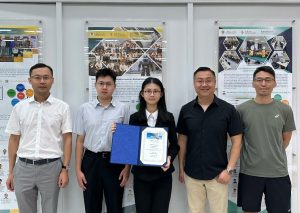Lam Lam and Song Naihe, recent graduates in the Department of Electromechanical Engineering (EME) of the Faculty of Science and Technology, University of Macau (UM), presented their research on hyperthermia applications at the 7th International Workshop on Heat-Mass Transfer Advances for Energy Conservation and Pollution Control (IWHT 2023). The study provides a basis for the amount of heat required by microrobots to generate hyperthermia in blood vessels. It was well received by the judges and won the best paper award.
The award-winning research project ‘An Investigation of Hyperthermia for Non-Newtonian Fluid inside an Imitation Circular Vein’ was built on Lam and Song’s final year project. Under the guidance of Tam Lap Mou and Xu Qingsong, professors in the EME, Lam and Song designed the experimental method, built the measurement platform, and managed the fabrication of artificial blood, data collection, and analysis. Tam Hou Kuan, EME PhD graduate at UM, gave them professional advice on selecting experimental equipment, while PhD candidate Yang Yifan assisted them in developing a numerical simulation model to carry out comparative analyses of experimental data. Lam and Song are currently pursuing further studies and research in thermal engineering at UM and Tsinghua University.
Hyperthermia is a type of oncological treatment that aims to raise the body temperature of the target subject above the normal value. Previous studies have shown that when the temperature of a cell or mass is raised to 43 ℃, the destruction of the mass can be observed. Thanks to significant advancements in manufacturing technologies and robotics in recent years, thermal engineering researchers are able to conduct hyperthermia experiments using artificial veins, artificial blood, and microrobots with mobility and heating functions. The study aimed to determine the magnitude of the heat source required to generate hyperthermia and the section that hyperthermia can cover. A blood circulation system with a pulsation flow rate of 5 cm/s was built, and an artificial vein, with an inner diameter of 2 mm and a length of 6 cm, was used as the test section. Non-Newtonian artificial blood was used as the test fluid, and the entrance temperature of the test section was kept at 37 ℃. A small-scale resistance heat source, which was used to mimic the heat generated by microrobots, was placed inside the artificial vein to enhance the inner wall temperature of the test section. Different heating inputs were used, and it was found that hyperthermia was observed when the heat input was in the vicinity of 0.22 W. The research results of the study provide a basis for the amount of heat required by the microrobots to generate hyperthermia in blood vessels. The research project was supported by the Institute for the Development and Quality, Macau.
The International Workshop on Heat-Mass Transfer Advances for Energy Conservation and Pollution Control (IWHT), launched by the MOE Laboratory of Thermo-Fluid Science and Engineering of Xi’an Jiaotong University in 2011, is an international conference for exchanging research results on advanced heat and mass transfer technologies and areas related to energy saving and pollution control. The conference was held every two years, and the previous editions were held in Russia, the United States, China’s Harbin, Xi’an, and Taiwan. It has become one of the top conferences in the field, attracting experts from all over the world. This year’s IWHT was hosted by Tokushima University in Japan, and Tao Wenquan, a member of the Chinese Academy of Sciences, was the chairman of the International Scientific Committee. More than 130 papers were presented at the conference, and the paper presented by UM was one of the four best papers selected by a committee comprising experts from the United States, Japan, and China.
| Source: Faculty of Science and Technology | |
| Media Contact Information: | |
| Communications Office, University of Macau | |
| Albee Lei | Tel: (853) 8822 8004 |
| Jason Leong | Tel: (853) 8822 8322 |
| Email: | prs.media@um.edu.mo |

